Competitive Analysis of Thomson Airways: Strategies and Positioning
VerifiedAdded on 2020/07/22
|10
|3115
|65
Report
AI Summary
This report provides a comprehensive competitive analysis of Thomson Airways within the aviation industry. It begins with an introduction outlining the importance of competitive analysis in achieving business objectives, followed by a background on Thomson Airways, including its market share, revenue, and workforce. The report then utilizes Porter's Five Forces model to assess the competitive landscape, examining factors such as competitive rivalry, the threat of new entrants, substitutes, customer bargaining power, and supplier bargaining power. A comparison of Thomson Airways with major competitors like easyJet, British Airways, and Thomas Cook is presented, evaluating factors like pricing, supply chain, brand value, marketing, human resources, and service quality. The report also highlights Thomson Airways' competitive advantages, such as its strong brand image and focus on customer service, and analyzes its position over different periods, including financial performance and technological advancements. Finally, the report discusses the strategies employed by Thomson Airways to maintain a strong market position, such as offering charter flights and focusing on service quality.
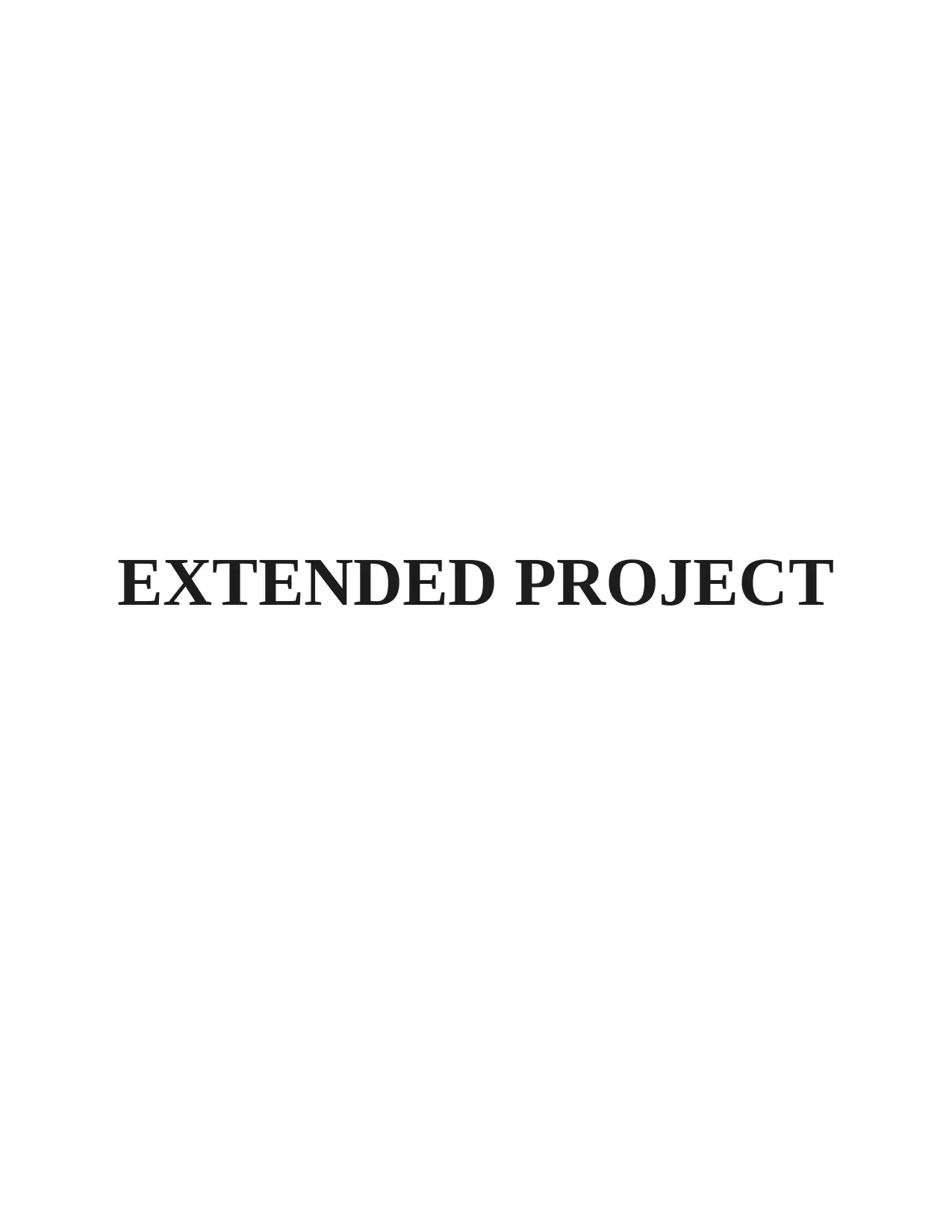
EXTENDED PROJECT
Paraphrase This Document
Need a fresh take? Get an instant paraphrase of this document with our AI Paraphraser
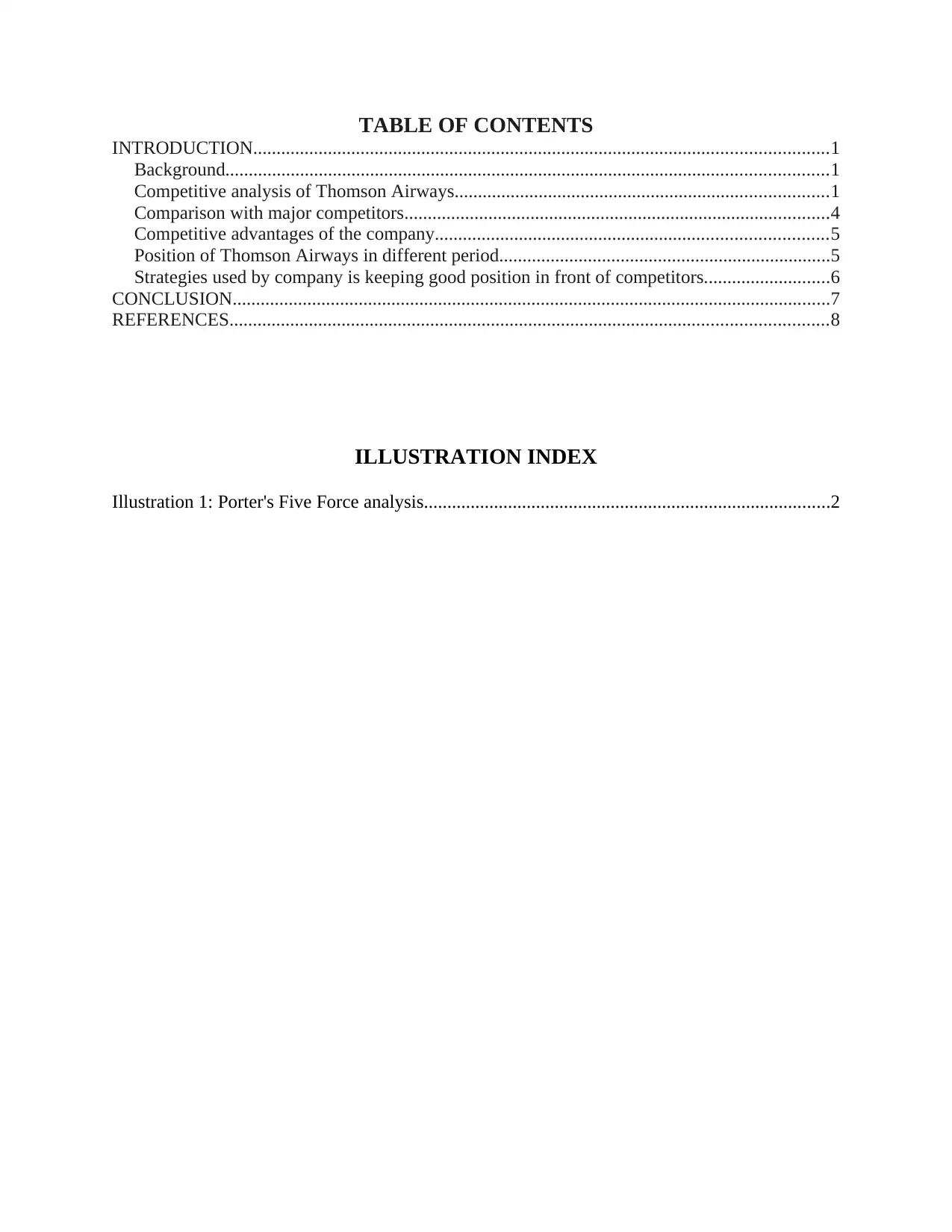
TABLE OF CONTENTS
INTRODUCTION...........................................................................................................................1
Background.................................................................................................................................1
Competitive analysis of Thomson Airways................................................................................1
Comparison with major competitors...........................................................................................4
Competitive advantages of the company....................................................................................5
Position of Thomson Airways in different period.......................................................................5
Strategies used by company is keeping good position in front of competitors...........................6
CONCLUSION................................................................................................................................7
REFERENCES................................................................................................................................8
ILLUSTRATION INDEX
Illustration 1: Porter's Five Force analysis.......................................................................................2
INTRODUCTION...........................................................................................................................1
Background.................................................................................................................................1
Competitive analysis of Thomson Airways................................................................................1
Comparison with major competitors...........................................................................................4
Competitive advantages of the company....................................................................................5
Position of Thomson Airways in different period.......................................................................5
Strategies used by company is keeping good position in front of competitors...........................6
CONCLUSION................................................................................................................................7
REFERENCES................................................................................................................................8
ILLUSTRATION INDEX
Illustration 1: Porter's Five Force analysis.......................................................................................2
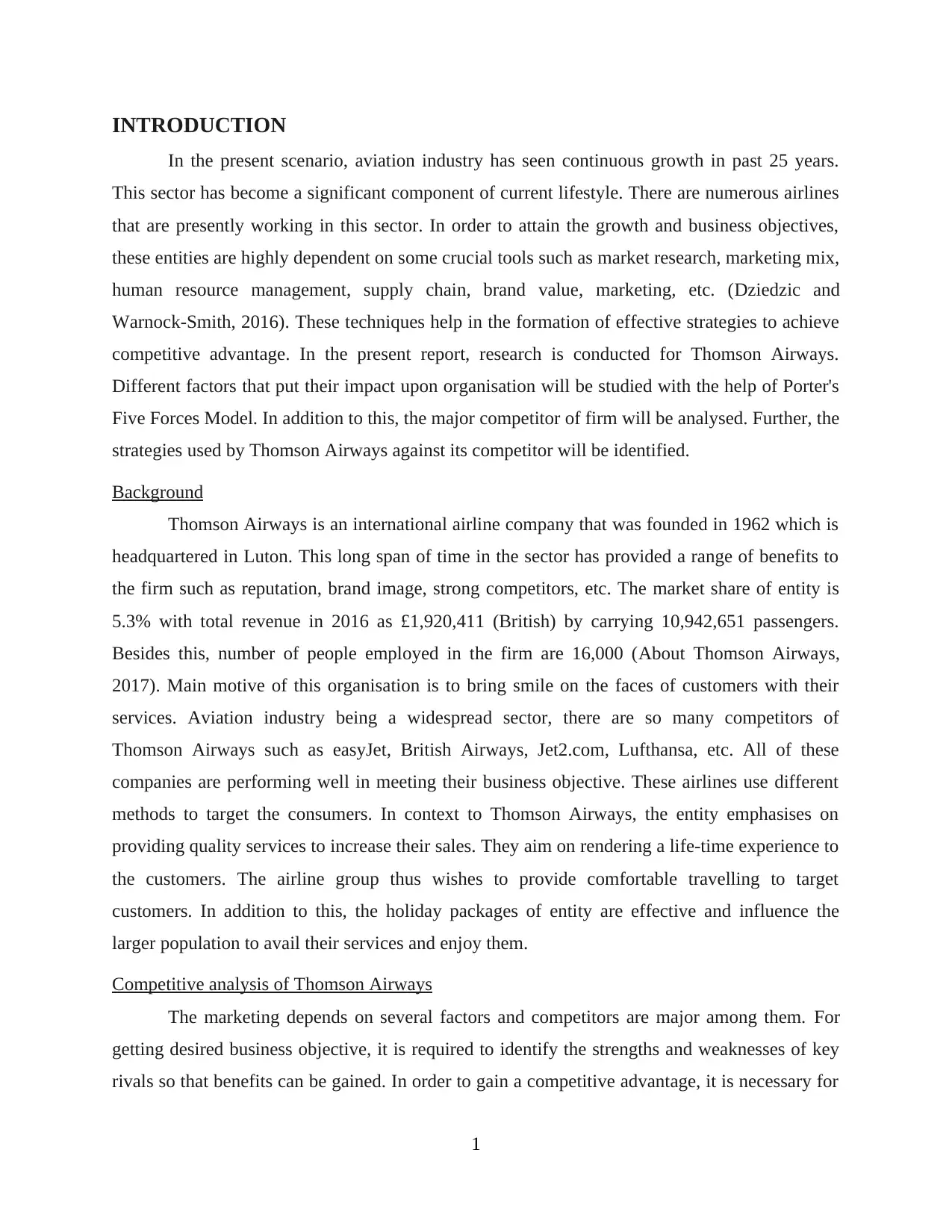
INTRODUCTION
In the present scenario, aviation industry has seen continuous growth in past 25 years.
This sector has become a significant component of current lifestyle. There are numerous airlines
that are presently working in this sector. In order to attain the growth and business objectives,
these entities are highly dependent on some crucial tools such as market research, marketing mix,
human resource management, supply chain, brand value, marketing, etc. (Dziedzic and
Warnock-Smith, 2016). These techniques help in the formation of effective strategies to achieve
competitive advantage. In the present report, research is conducted for Thomson Airways.
Different factors that put their impact upon organisation will be studied with the help of Porter's
Five Forces Model. In addition to this, the major competitor of firm will be analysed. Further, the
strategies used by Thomson Airways against its competitor will be identified.
Background
Thomson Airways is an international airline company that was founded in 1962 which is
headquartered in Luton. This long span of time in the sector has provided a range of benefits to
the firm such as reputation, brand image, strong competitors, etc. The market share of entity is
5.3% with total revenue in 2016 as £1,920,411 (British) by carrying 10,942,651 passengers.
Besides this, number of people employed in the firm are 16,000 (About Thomson Airways,
2017). Main motive of this organisation is to bring smile on the faces of customers with their
services. Aviation industry being a widespread sector, there are so many competitors of
Thomson Airways such as easyJet, British Airways, Jet2.com, Lufthansa, etc. All of these
companies are performing well in meeting their business objective. These airlines use different
methods to target the consumers. In context to Thomson Airways, the entity emphasises on
providing quality services to increase their sales. They aim on rendering a life-time experience to
the customers. The airline group thus wishes to provide comfortable travelling to target
customers. In addition to this, the holiday packages of entity are effective and influence the
larger population to avail their services and enjoy them.
Competitive analysis of Thomson Airways
The marketing depends on several factors and competitors are major among them. For
getting desired business objective, it is required to identify the strengths and weaknesses of key
rivals so that benefits can be gained. In order to gain a competitive advantage, it is necessary for
1
In the present scenario, aviation industry has seen continuous growth in past 25 years.
This sector has become a significant component of current lifestyle. There are numerous airlines
that are presently working in this sector. In order to attain the growth and business objectives,
these entities are highly dependent on some crucial tools such as market research, marketing mix,
human resource management, supply chain, brand value, marketing, etc. (Dziedzic and
Warnock-Smith, 2016). These techniques help in the formation of effective strategies to achieve
competitive advantage. In the present report, research is conducted for Thomson Airways.
Different factors that put their impact upon organisation will be studied with the help of Porter's
Five Forces Model. In addition to this, the major competitor of firm will be analysed. Further, the
strategies used by Thomson Airways against its competitor will be identified.
Background
Thomson Airways is an international airline company that was founded in 1962 which is
headquartered in Luton. This long span of time in the sector has provided a range of benefits to
the firm such as reputation, brand image, strong competitors, etc. The market share of entity is
5.3% with total revenue in 2016 as £1,920,411 (British) by carrying 10,942,651 passengers.
Besides this, number of people employed in the firm are 16,000 (About Thomson Airways,
2017). Main motive of this organisation is to bring smile on the faces of customers with their
services. Aviation industry being a widespread sector, there are so many competitors of
Thomson Airways such as easyJet, British Airways, Jet2.com, Lufthansa, etc. All of these
companies are performing well in meeting their business objective. These airlines use different
methods to target the consumers. In context to Thomson Airways, the entity emphasises on
providing quality services to increase their sales. They aim on rendering a life-time experience to
the customers. The airline group thus wishes to provide comfortable travelling to target
customers. In addition to this, the holiday packages of entity are effective and influence the
larger population to avail their services and enjoy them.
Competitive analysis of Thomson Airways
The marketing depends on several factors and competitors are major among them. For
getting desired business objective, it is required to identify the strengths and weaknesses of key
rivals so that benefits can be gained. In order to gain a competitive advantage, it is necessary for
1
⊘ This is a preview!⊘
Do you want full access?
Subscribe today to unlock all pages.

Trusted by 1+ million students worldwide
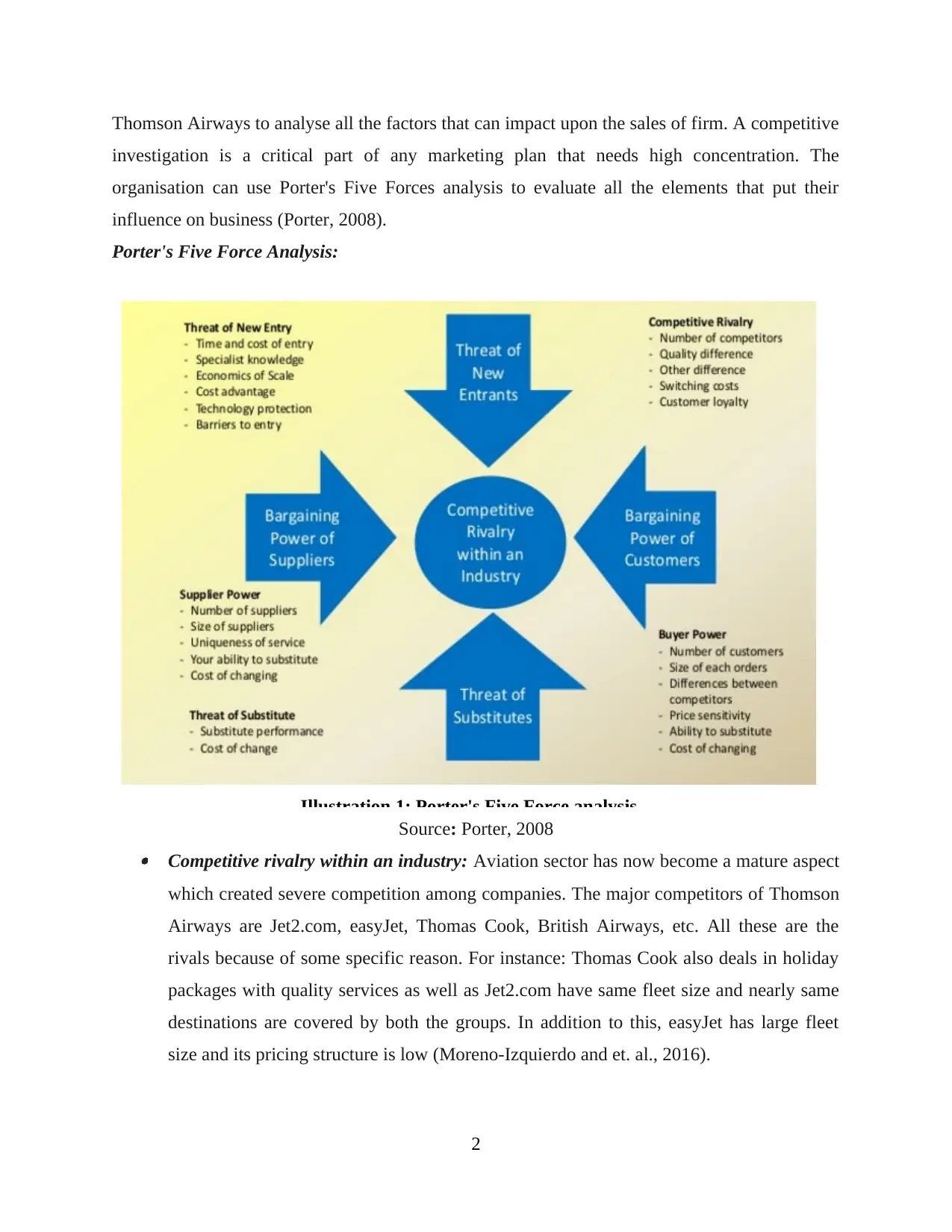
Thomson Airways to analyse all the factors that can impact upon the sales of firm. A competitive
investigation is a critical part of any marketing plan that needs high concentration. The
organisation can use Porter's Five Forces analysis to evaluate all the elements that put their
influence on business (Porter, 2008).
Porter's Five Force Analysis:
Source: Porter, 2008 Competitive rivalry within an industry: Aviation sector has now become a mature aspect
which created severe competition among companies. The major competitors of Thomson
Airways are Jet2.com, easyJet, Thomas Cook, British Airways, etc. All these are the
rivals because of some specific reason. For instance: Thomas Cook also deals in holiday
packages with quality services as well as Jet2.com have same fleet size and nearly same
destinations are covered by both the groups. In addition to this, easyJet has large fleet
size and its pricing structure is low (Moreno-Izquierdo and et. al., 2016).
2
Illustration 1: Porter's Five Force analysis
investigation is a critical part of any marketing plan that needs high concentration. The
organisation can use Porter's Five Forces analysis to evaluate all the elements that put their
influence on business (Porter, 2008).
Porter's Five Force Analysis:
Source: Porter, 2008 Competitive rivalry within an industry: Aviation sector has now become a mature aspect
which created severe competition among companies. The major competitors of Thomson
Airways are Jet2.com, easyJet, Thomas Cook, British Airways, etc. All these are the
rivals because of some specific reason. For instance: Thomas Cook also deals in holiday
packages with quality services as well as Jet2.com have same fleet size and nearly same
destinations are covered by both the groups. In addition to this, easyJet has large fleet
size and its pricing structure is low (Moreno-Izquierdo and et. al., 2016).
2
Illustration 1: Porter's Five Force analysis
Paraphrase This Document
Need a fresh take? Get an instant paraphrase of this document with our AI Paraphraser
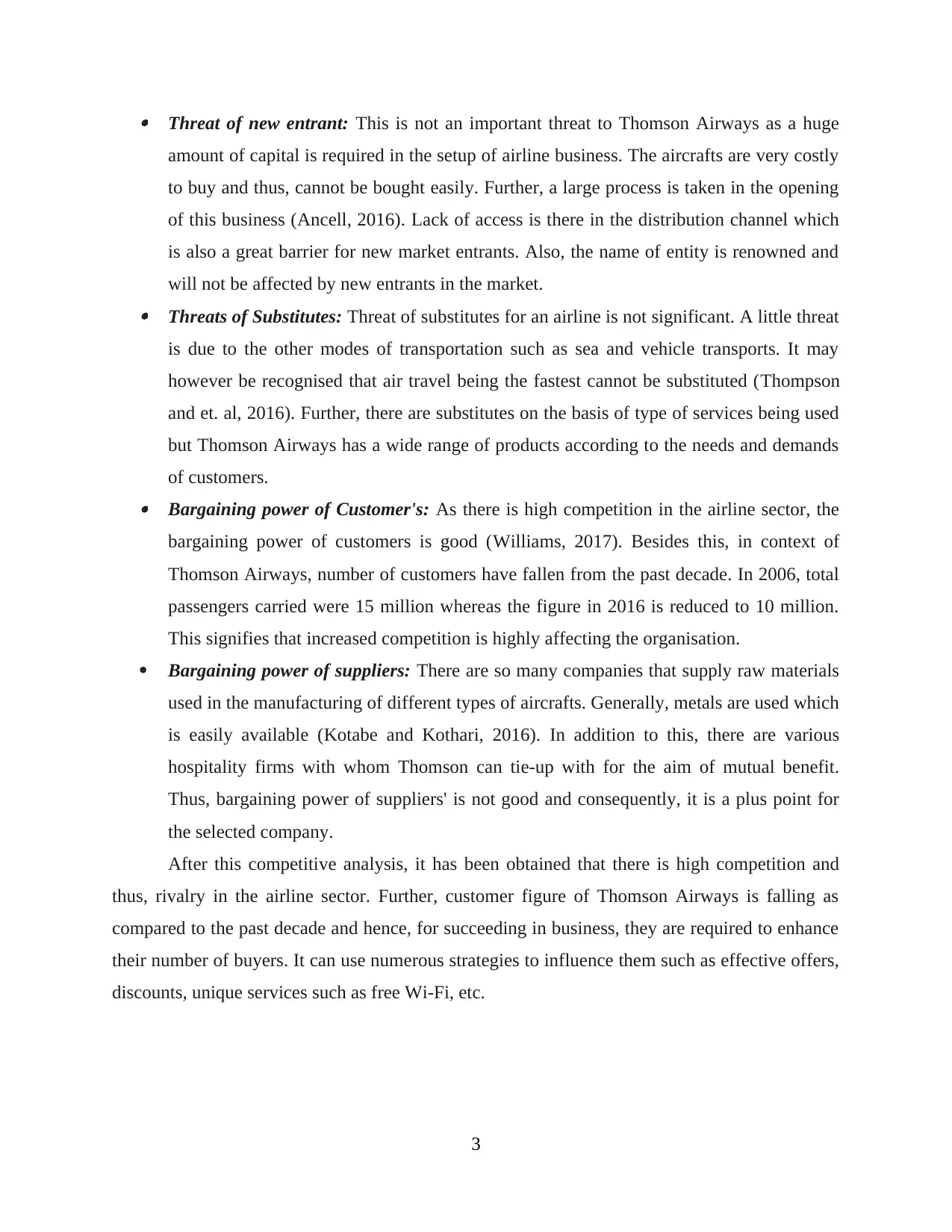
Threat of new entrant: This is not an important threat to Thomson Airways as a huge
amount of capital is required in the setup of airline business. The aircrafts are very costly
to buy and thus, cannot be bought easily. Further, a large process is taken in the opening
of this business (Ancell, 2016). Lack of access is there in the distribution channel which
is also a great barrier for new market entrants. Also, the name of entity is renowned and
will not be affected by new entrants in the market. Threats of Substitutes: Threat of substitutes for an airline is not significant. A little threat
is due to the other modes of transportation such as sea and vehicle transports. It may
however be recognised that air travel being the fastest cannot be substituted (Thompson
and et. al, 2016). Further, there are substitutes on the basis of type of services being used
but Thomson Airways has a wide range of products according to the needs and demands
of customers. Bargaining power of Customer's: As there is high competition in the airline sector, the
bargaining power of customers is good (Williams, 2017). Besides this, in context of
Thomson Airways, number of customers have fallen from the past decade. In 2006, total
passengers carried were 15 million whereas the figure in 2016 is reduced to 10 million.
This signifies that increased competition is highly affecting the organisation.
Bargaining power of suppliers: There are so many companies that supply raw materials
used in the manufacturing of different types of aircrafts. Generally, metals are used which
is easily available (Kotabe and Kothari, 2016). In addition to this, there are various
hospitality firms with whom Thomson can tie-up with for the aim of mutual benefit.
Thus, bargaining power of suppliers' is not good and consequently, it is a plus point for
the selected company.
After this competitive analysis, it has been obtained that there is high competition and
thus, rivalry in the airline sector. Further, customer figure of Thomson Airways is falling as
compared to the past decade and hence, for succeeding in business, they are required to enhance
their number of buyers. It can use numerous strategies to influence them such as effective offers,
discounts, unique services such as free Wi-Fi, etc.
3
amount of capital is required in the setup of airline business. The aircrafts are very costly
to buy and thus, cannot be bought easily. Further, a large process is taken in the opening
of this business (Ancell, 2016). Lack of access is there in the distribution channel which
is also a great barrier for new market entrants. Also, the name of entity is renowned and
will not be affected by new entrants in the market. Threats of Substitutes: Threat of substitutes for an airline is not significant. A little threat
is due to the other modes of transportation such as sea and vehicle transports. It may
however be recognised that air travel being the fastest cannot be substituted (Thompson
and et. al, 2016). Further, there are substitutes on the basis of type of services being used
but Thomson Airways has a wide range of products according to the needs and demands
of customers. Bargaining power of Customer's: As there is high competition in the airline sector, the
bargaining power of customers is good (Williams, 2017). Besides this, in context of
Thomson Airways, number of customers have fallen from the past decade. In 2006, total
passengers carried were 15 million whereas the figure in 2016 is reduced to 10 million.
This signifies that increased competition is highly affecting the organisation.
Bargaining power of suppliers: There are so many companies that supply raw materials
used in the manufacturing of different types of aircrafts. Generally, metals are used which
is easily available (Kotabe and Kothari, 2016). In addition to this, there are various
hospitality firms with whom Thomson can tie-up with for the aim of mutual benefit.
Thus, bargaining power of suppliers' is not good and consequently, it is a plus point for
the selected company.
After this competitive analysis, it has been obtained that there is high competition and
thus, rivalry in the airline sector. Further, customer figure of Thomson Airways is falling as
compared to the past decade and hence, for succeeding in business, they are required to enhance
their number of buyers. It can use numerous strategies to influence them such as effective offers,
discounts, unique services such as free Wi-Fi, etc.
3
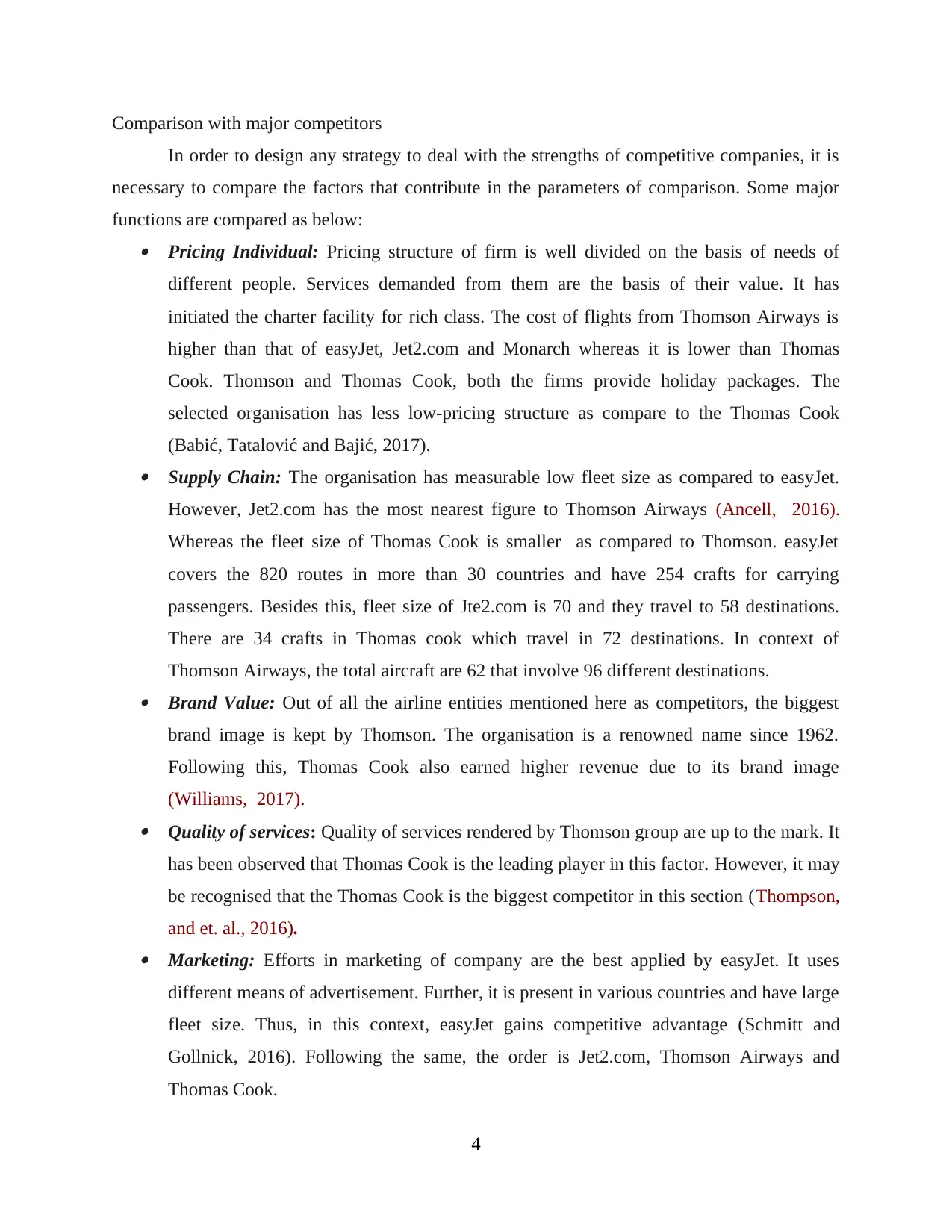
Comparison with major competitors
In order to design any strategy to deal with the strengths of competitive companies, it is
necessary to compare the factors that contribute in the parameters of comparison. Some major
functions are compared as below: Pricing Individual: Pricing structure of firm is well divided on the basis of needs of
different people. Services demanded from them are the basis of their value. It has
initiated the charter facility for rich class. The cost of flights from Thomson Airways is
higher than that of easyJet, Jet2.com and Monarch whereas it is lower than Thomas
Cook. Thomson and Thomas Cook, both the firms provide holiday packages. The
selected organisation has less low-pricing structure as compare to the Thomas Cook
(Babić, Tatalović and Bajić, 2017). Supply Chain: The organisation has measurable low fleet size as compared to easyJet.
However, Jet2.com has the most nearest figure to Thomson Airways (Ancell, 2016).
Whereas the fleet size of Thomas Cook is smaller as compared to Thomson. easyJet
covers the 820 routes in more than 30 countries and have 254 crafts for carrying
passengers. Besides this, fleet size of Jte2.com is 70 and they travel to 58 destinations.
There are 34 crafts in Thomas cook which travel in 72 destinations. In context of
Thomson Airways, the total aircraft are 62 that involve 96 different destinations. Brand Value: Out of all the airline entities mentioned here as competitors, the biggest
brand image is kept by Thomson. The organisation is a renowned name since 1962.
Following this, Thomas Cook also earned higher revenue due to its brand image
(Williams, 2017). Quality of services: Quality of services rendered by Thomson group are up to the mark. It
has been observed that Thomas Cook is the leading player in this factor. However, it may
be recognised that the Thomas Cook is the biggest competitor in this section (Thompson,
and et. al., 2016). Marketing: Efforts in marketing of company are the best applied by easyJet. It uses
different means of advertisement. Further, it is present in various countries and have large
fleet size. Thus, in this context, easyJet gains competitive advantage (Schmitt and
Gollnick, 2016). Following the same, the order is Jet2.com, Thomson Airways and
Thomas Cook.
4
In order to design any strategy to deal with the strengths of competitive companies, it is
necessary to compare the factors that contribute in the parameters of comparison. Some major
functions are compared as below: Pricing Individual: Pricing structure of firm is well divided on the basis of needs of
different people. Services demanded from them are the basis of their value. It has
initiated the charter facility for rich class. The cost of flights from Thomson Airways is
higher than that of easyJet, Jet2.com and Monarch whereas it is lower than Thomas
Cook. Thomson and Thomas Cook, both the firms provide holiday packages. The
selected organisation has less low-pricing structure as compare to the Thomas Cook
(Babić, Tatalović and Bajić, 2017). Supply Chain: The organisation has measurable low fleet size as compared to easyJet.
However, Jet2.com has the most nearest figure to Thomson Airways (Ancell, 2016).
Whereas the fleet size of Thomas Cook is smaller as compared to Thomson. easyJet
covers the 820 routes in more than 30 countries and have 254 crafts for carrying
passengers. Besides this, fleet size of Jte2.com is 70 and they travel to 58 destinations.
There are 34 crafts in Thomas cook which travel in 72 destinations. In context of
Thomson Airways, the total aircraft are 62 that involve 96 different destinations. Brand Value: Out of all the airline entities mentioned here as competitors, the biggest
brand image is kept by Thomson. The organisation is a renowned name since 1962.
Following this, Thomas Cook also earned higher revenue due to its brand image
(Williams, 2017). Quality of services: Quality of services rendered by Thomson group are up to the mark. It
has been observed that Thomas Cook is the leading player in this factor. However, it may
be recognised that the Thomas Cook is the biggest competitor in this section (Thompson,
and et. al., 2016). Marketing: Efforts in marketing of company are the best applied by easyJet. It uses
different means of advertisement. Further, it is present in various countries and have large
fleet size. Thus, in this context, easyJet gains competitive advantage (Schmitt and
Gollnick, 2016). Following the same, the order is Jet2.com, Thomson Airways and
Thomas Cook.
4
⊘ This is a preview!⊘
Do you want full access?
Subscribe today to unlock all pages.

Trusted by 1+ million students worldwide
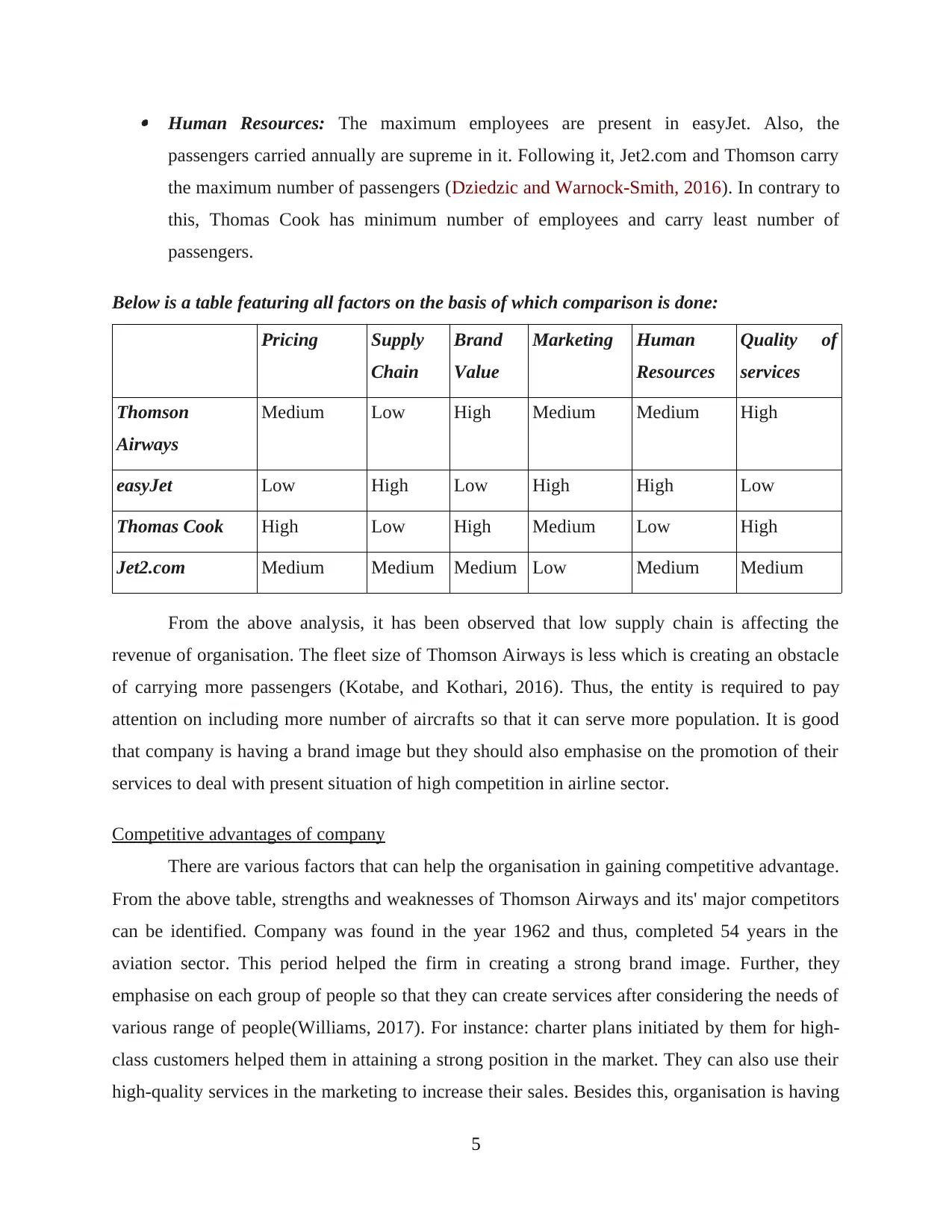
Human Resources: The maximum employees are present in easyJet. Also, the
passengers carried annually are supreme in it. Following it, Jet2.com and Thomson carry
the maximum number of passengers (Dziedzic and Warnock-Smith, 2016). In contrary to
this, Thomas Cook has minimum number of employees and carry least number of
passengers.
Below is a table featuring all factors on the basis of which comparison is done:
Pricing Supply
Chain
Brand
Value
Marketing Human
Resources
Quality of
services
Thomson
Airways
Medium Low High Medium Medium High
easyJet Low High Low High High Low
Thomas Cook High Low High Medium Low High
Jet2.com Medium Medium Medium Low Medium Medium
From the above analysis, it has been observed that low supply chain is affecting the
revenue of organisation. The fleet size of Thomson Airways is less which is creating an obstacle
of carrying more passengers (Kotabe, and Kothari, 2016). Thus, the entity is required to pay
attention on including more number of aircrafts so that it can serve more population. It is good
that company is having a brand image but they should also emphasise on the promotion of their
services to deal with present situation of high competition in airline sector.
Competitive advantages of company
There are various factors that can help the organisation in gaining competitive advantage.
From the above table, strengths and weaknesses of Thomson Airways and its' major competitors
can be identified. Company was found in the year 1962 and thus, completed 54 years in the
aviation sector. This period helped the firm in creating a strong brand image. Further, they
emphasise on each group of people so that they can create services after considering the needs of
various range of people(Williams, 2017). For instance: charter plans initiated by them for high-
class customers helped them in attaining a strong position in the market. They can also use their
high-quality services in the marketing to increase their sales. Besides this, organisation is having
5
passengers carried annually are supreme in it. Following it, Jet2.com and Thomson carry
the maximum number of passengers (Dziedzic and Warnock-Smith, 2016). In contrary to
this, Thomas Cook has minimum number of employees and carry least number of
passengers.
Below is a table featuring all factors on the basis of which comparison is done:
Pricing Supply
Chain
Brand
Value
Marketing Human
Resources
Quality of
services
Thomson
Airways
Medium Low High Medium Medium High
easyJet Low High Low High High Low
Thomas Cook High Low High Medium Low High
Jet2.com Medium Medium Medium Low Medium Medium
From the above analysis, it has been observed that low supply chain is affecting the
revenue of organisation. The fleet size of Thomson Airways is less which is creating an obstacle
of carrying more passengers (Kotabe, and Kothari, 2016). Thus, the entity is required to pay
attention on including more number of aircrafts so that it can serve more population. It is good
that company is having a brand image but they should also emphasise on the promotion of their
services to deal with present situation of high competition in airline sector.
Competitive advantages of company
There are various factors that can help the organisation in gaining competitive advantage.
From the above table, strengths and weaknesses of Thomson Airways and its' major competitors
can be identified. Company was found in the year 1962 and thus, completed 54 years in the
aviation sector. This period helped the firm in creating a strong brand image. Further, they
emphasise on each group of people so that they can create services after considering the needs of
various range of people(Williams, 2017). For instance: charter plans initiated by them for high-
class customers helped them in attaining a strong position in the market. They can also use their
high-quality services in the marketing to increase their sales. Besides this, organisation is having
5
Paraphrase This Document
Need a fresh take? Get an instant paraphrase of this document with our AI Paraphraser
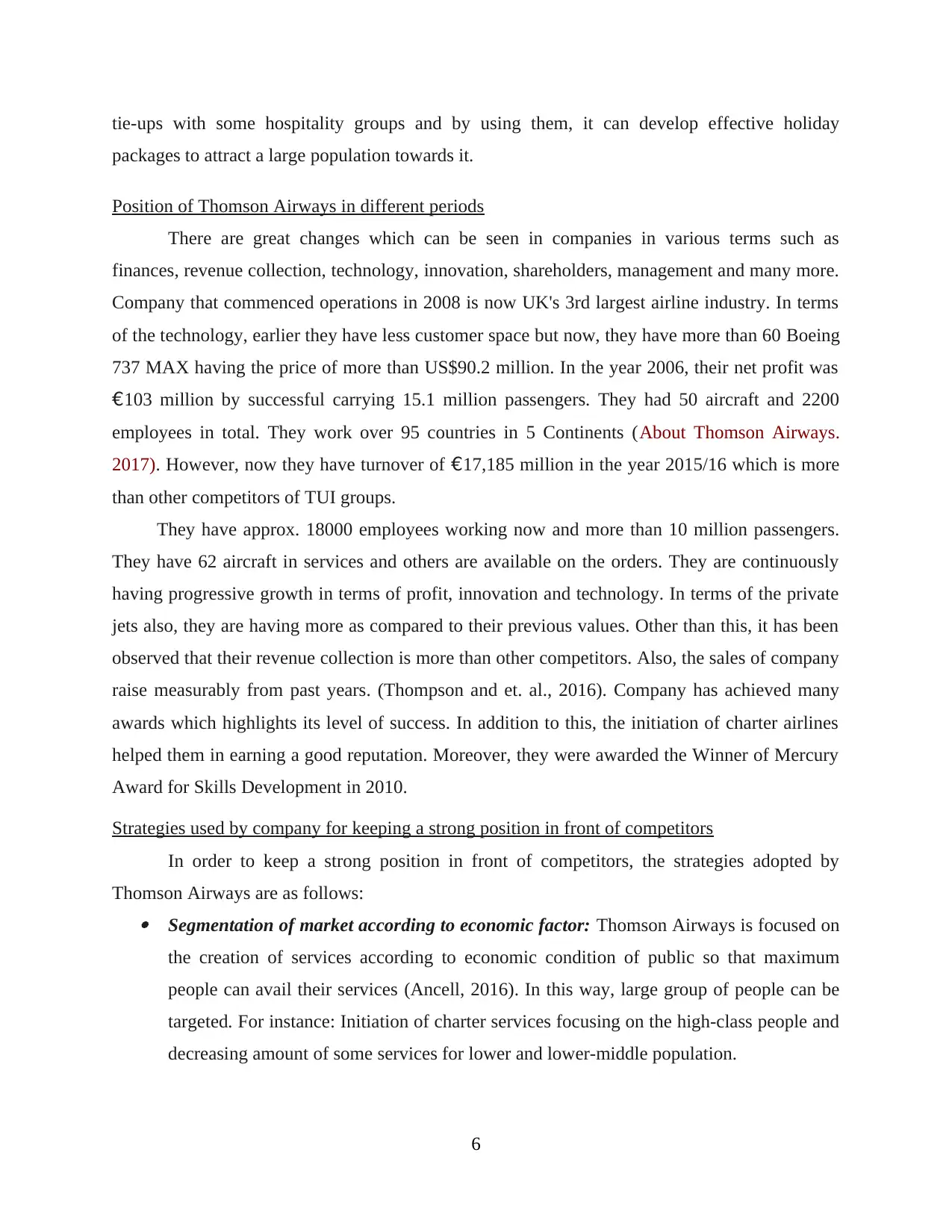
tie-ups with some hospitality groups and by using them, it can develop effective holiday
packages to attract a large population towards it.
Position of Thomson Airways in different periods
There are great changes which can be seen in companies in various terms such as
finances, revenue collection, technology, innovation, shareholders, management and many more.
Company that commenced operations in 2008 is now UK's 3rd largest airline industry. In terms
of the technology, earlier they have less customer space but now, they have more than 60 Boeing
737 MAX having the price of more than US$90.2 million. In the year 2006, their net profit was
€103 million by successful carrying 15.1 million passengers. They had 50 aircraft and 2200
employees in total. They work over 95 countries in 5 Continents (About Thomson Airways.
2017). However, now they have turnover of €17,185 million in the year 2015/16 which is more
than other competitors of TUI groups.
They have approx. 18000 employees working now and more than 10 million passengers.
They have 62 aircraft in services and others are available on the orders. They are continuously
having progressive growth in terms of profit, innovation and technology. In terms of the private
jets also, they are having more as compared to their previous values. Other than this, it has been
observed that their revenue collection is more than other competitors. Also, the sales of company
raise measurably from past years. (Thompson and et. al., 2016). Company has achieved many
awards which highlights its level of success. In addition to this, the initiation of charter airlines
helped them in earning a good reputation. Moreover, they were awarded the Winner of Mercury
Award for Skills Development in 2010.
Strategies used by company for keeping a strong position in front of competitors
In order to keep a strong position in front of competitors, the strategies adopted by
Thomson Airways are as follows: Segmentation of market according to economic factor: Thomson Airways is focused on
the creation of services according to economic condition of public so that maximum
people can avail their services (Ancell, 2016). In this way, large group of people can be
targeted. For instance: Initiation of charter services focusing on the high-class people and
decreasing amount of some services for lower and lower-middle population.
6
packages to attract a large population towards it.
Position of Thomson Airways in different periods
There are great changes which can be seen in companies in various terms such as
finances, revenue collection, technology, innovation, shareholders, management and many more.
Company that commenced operations in 2008 is now UK's 3rd largest airline industry. In terms
of the technology, earlier they have less customer space but now, they have more than 60 Boeing
737 MAX having the price of more than US$90.2 million. In the year 2006, their net profit was
€103 million by successful carrying 15.1 million passengers. They had 50 aircraft and 2200
employees in total. They work over 95 countries in 5 Continents (About Thomson Airways.
2017). However, now they have turnover of €17,185 million in the year 2015/16 which is more
than other competitors of TUI groups.
They have approx. 18000 employees working now and more than 10 million passengers.
They have 62 aircraft in services and others are available on the orders. They are continuously
having progressive growth in terms of profit, innovation and technology. In terms of the private
jets also, they are having more as compared to their previous values. Other than this, it has been
observed that their revenue collection is more than other competitors. Also, the sales of company
raise measurably from past years. (Thompson and et. al., 2016). Company has achieved many
awards which highlights its level of success. In addition to this, the initiation of charter airlines
helped them in earning a good reputation. Moreover, they were awarded the Winner of Mercury
Award for Skills Development in 2010.
Strategies used by company for keeping a strong position in front of competitors
In order to keep a strong position in front of competitors, the strategies adopted by
Thomson Airways are as follows: Segmentation of market according to economic factor: Thomson Airways is focused on
the creation of services according to economic condition of public so that maximum
people can avail their services (Ancell, 2016). In this way, large group of people can be
targeted. For instance: Initiation of charter services focusing on the high-class people and
decreasing amount of some services for lower and lower-middle population.
6
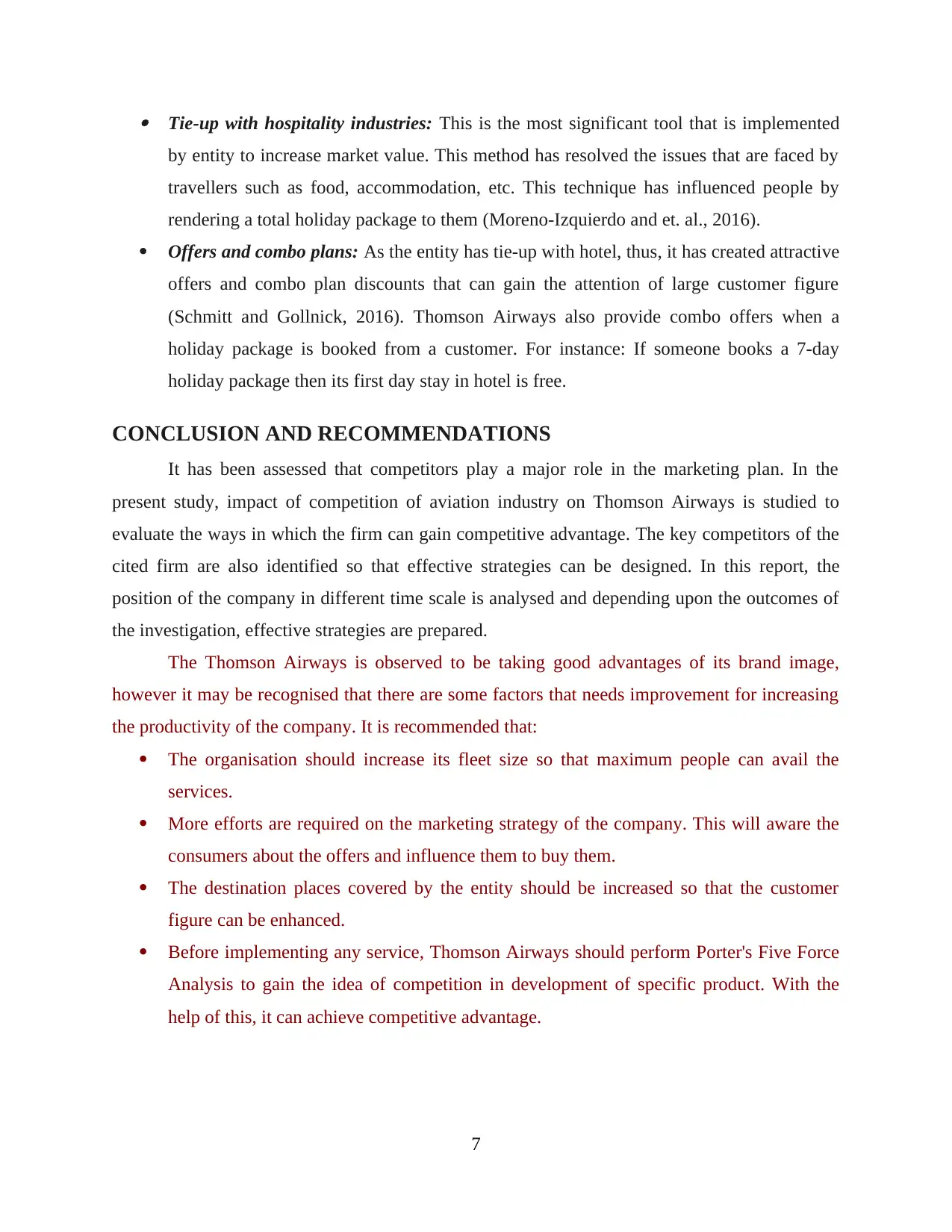
Tie-up with hospitality industries: This is the most significant tool that is implemented
by entity to increase market value. This method has resolved the issues that are faced by
travellers such as food, accommodation, etc. This technique has influenced people by
rendering a total holiday package to them (Moreno-Izquierdo and et. al., 2016).
Offers and combo plans: As the entity has tie-up with hotel, thus, it has created attractive
offers and combo plan discounts that can gain the attention of large customer figure
(Schmitt and Gollnick, 2016). Thomson Airways also provide combo offers when a
holiday package is booked from a customer. For instance: If someone books a 7-day
holiday package then its first day stay in hotel is free.
CONCLUSION AND RECOMMENDATIONS
It has been assessed that competitors play a major role in the marketing plan. In the
present study, impact of competition of aviation industry on Thomson Airways is studied to
evaluate the ways in which the firm can gain competitive advantage. The key competitors of the
cited firm are also identified so that effective strategies can be designed. In this report, the
position of the company in different time scale is analysed and depending upon the outcomes of
the investigation, effective strategies are prepared.
The Thomson Airways is observed to be taking good advantages of its brand image,
however it may be recognised that there are some factors that needs improvement for increasing
the productivity of the company. It is recommended that:
The organisation should increase its fleet size so that maximum people can avail the
services.
More efforts are required on the marketing strategy of the company. This will aware the
consumers about the offers and influence them to buy them.
The destination places covered by the entity should be increased so that the customer
figure can be enhanced.
Before implementing any service, Thomson Airways should perform Porter's Five Force
Analysis to gain the idea of competition in development of specific product. With the
help of this, it can achieve competitive advantage.
7
by entity to increase market value. This method has resolved the issues that are faced by
travellers such as food, accommodation, etc. This technique has influenced people by
rendering a total holiday package to them (Moreno-Izquierdo and et. al., 2016).
Offers and combo plans: As the entity has tie-up with hotel, thus, it has created attractive
offers and combo plan discounts that can gain the attention of large customer figure
(Schmitt and Gollnick, 2016). Thomson Airways also provide combo offers when a
holiday package is booked from a customer. For instance: If someone books a 7-day
holiday package then its first day stay in hotel is free.
CONCLUSION AND RECOMMENDATIONS
It has been assessed that competitors play a major role in the marketing plan. In the
present study, impact of competition of aviation industry on Thomson Airways is studied to
evaluate the ways in which the firm can gain competitive advantage. The key competitors of the
cited firm are also identified so that effective strategies can be designed. In this report, the
position of the company in different time scale is analysed and depending upon the outcomes of
the investigation, effective strategies are prepared.
The Thomson Airways is observed to be taking good advantages of its brand image,
however it may be recognised that there are some factors that needs improvement for increasing
the productivity of the company. It is recommended that:
The organisation should increase its fleet size so that maximum people can avail the
services.
More efforts are required on the marketing strategy of the company. This will aware the
consumers about the offers and influence them to buy them.
The destination places covered by the entity should be increased so that the customer
figure can be enhanced.
Before implementing any service, Thomson Airways should perform Porter's Five Force
Analysis to gain the idea of competition in development of specific product. With the
help of this, it can achieve competitive advantage.
7
⊘ This is a preview!⊘
Do you want full access?
Subscribe today to unlock all pages.

Trusted by 1+ million students worldwide
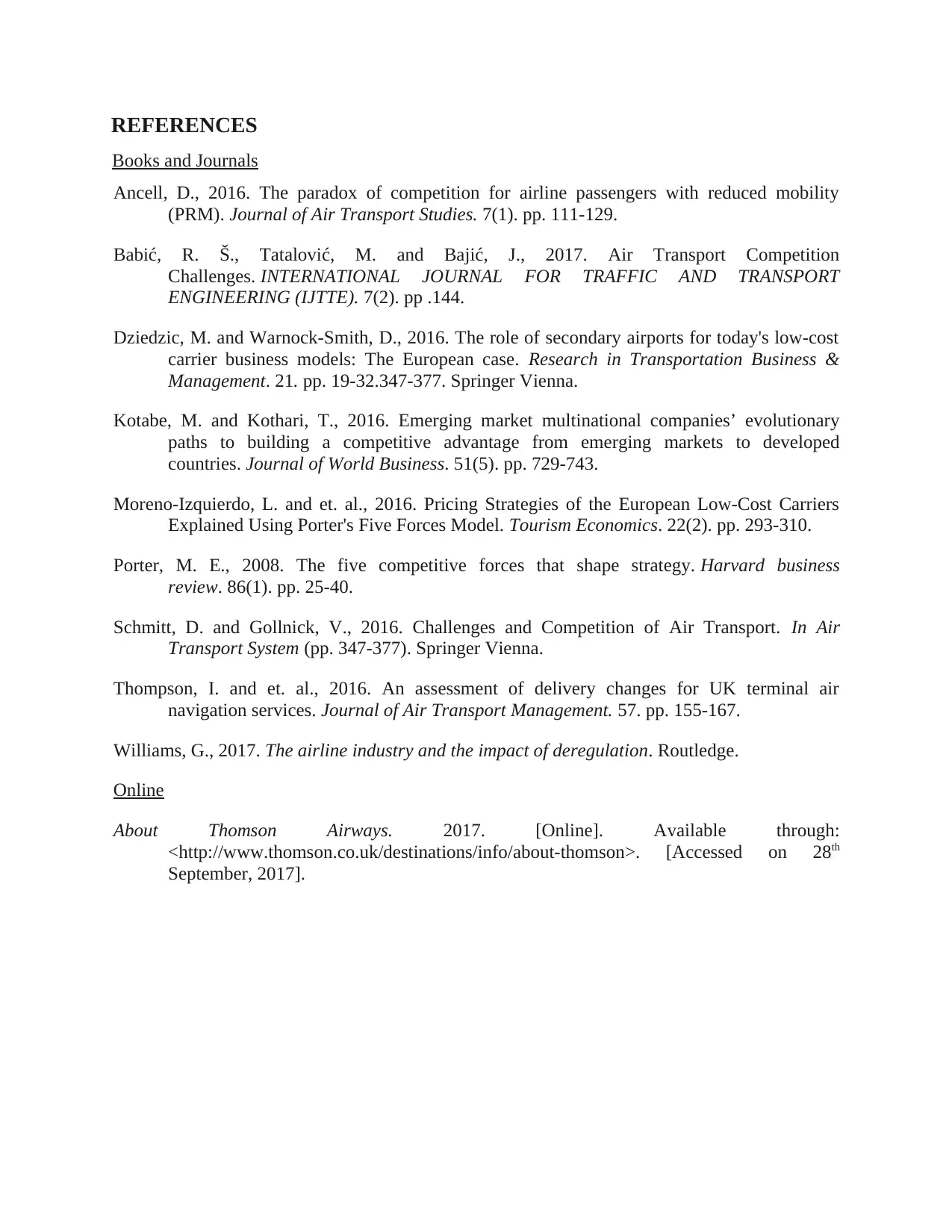
REFERENCES
Books and Journals
Ancell, D., 2016. The paradox of competition for airline passengers with reduced mobility
(PRM). Journal of Air Transport Studies. 7(1). pp. 111-129.
Babić, R. Š., Tatalović, M. and Bajić, J., 2017. Air Transport Competition
Challenges. INTERNATIONAL JOURNAL FOR TRAFFIC AND TRANSPORT
ENGINEERING (IJTTE). 7(2). pp .144.
Dziedzic, M. and Warnock-Smith, D., 2016. The role of secondary airports for today's low-cost
carrier business models: The European case. Research in Transportation Business &
Management. 21. pp. 19-32.347-377. Springer Vienna.
Kotabe, M. and Kothari, T., 2016. Emerging market multinational companies’ evolutionary
paths to building a competitive advantage from emerging markets to developed
countries. Journal of World Business. 51(5). pp. 729-743.
Moreno-Izquierdo, L. and et. al., 2016. Pricing Strategies of the European Low-Cost Carriers
Explained Using Porter's Five Forces Model. Tourism Economics. 22(2). pp. 293-310.
Porter, M. E., 2008. The five competitive forces that shape strategy. Harvard business
review. 86(1). pp. 25-40.
Schmitt, D. and Gollnick, V., 2016. Challenges and Competition of Air Transport. In Air
Transport System (pp. 347-377). Springer Vienna.
Thompson, I. and et. al., 2016. An assessment of delivery changes for UK terminal air
navigation services. Journal of Air Transport Management. 57. pp. 155-167.
Williams, G., 2017. The airline industry and the impact of deregulation. Routledge.
Online
About Thomson Airways. 2017. [Online]. Available through:
<http://www.thomson.co.uk/destinations/info/about-thomson>. [Accessed on 28th
September, 2017].
Books and Journals
Ancell, D., 2016. The paradox of competition for airline passengers with reduced mobility
(PRM). Journal of Air Transport Studies. 7(1). pp. 111-129.
Babić, R. Š., Tatalović, M. and Bajić, J., 2017. Air Transport Competition
Challenges. INTERNATIONAL JOURNAL FOR TRAFFIC AND TRANSPORT
ENGINEERING (IJTTE). 7(2). pp .144.
Dziedzic, M. and Warnock-Smith, D., 2016. The role of secondary airports for today's low-cost
carrier business models: The European case. Research in Transportation Business &
Management. 21. pp. 19-32.347-377. Springer Vienna.
Kotabe, M. and Kothari, T., 2016. Emerging market multinational companies’ evolutionary
paths to building a competitive advantage from emerging markets to developed
countries. Journal of World Business. 51(5). pp. 729-743.
Moreno-Izquierdo, L. and et. al., 2016. Pricing Strategies of the European Low-Cost Carriers
Explained Using Porter's Five Forces Model. Tourism Economics. 22(2). pp. 293-310.
Porter, M. E., 2008. The five competitive forces that shape strategy. Harvard business
review. 86(1). pp. 25-40.
Schmitt, D. and Gollnick, V., 2016. Challenges and Competition of Air Transport. In Air
Transport System (pp. 347-377). Springer Vienna.
Thompson, I. and et. al., 2016. An assessment of delivery changes for UK terminal air
navigation services. Journal of Air Transport Management. 57. pp. 155-167.
Williams, G., 2017. The airline industry and the impact of deregulation. Routledge.
Online
About Thomson Airways. 2017. [Online]. Available through:
<http://www.thomson.co.uk/destinations/info/about-thomson>. [Accessed on 28th
September, 2017].
1 out of 10
Related Documents
Your All-in-One AI-Powered Toolkit for Academic Success.
+13062052269
info@desklib.com
Available 24*7 on WhatsApp / Email
![[object Object]](/_next/static/media/star-bottom.7253800d.svg)
Unlock your academic potential
Copyright © 2020–2025 A2Z Services. All Rights Reserved. Developed and managed by ZUCOL.





